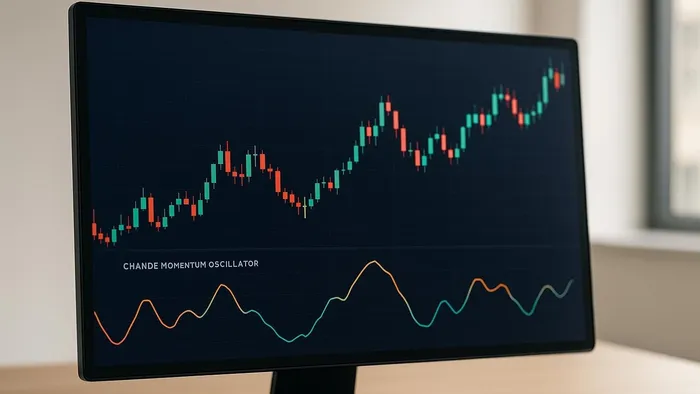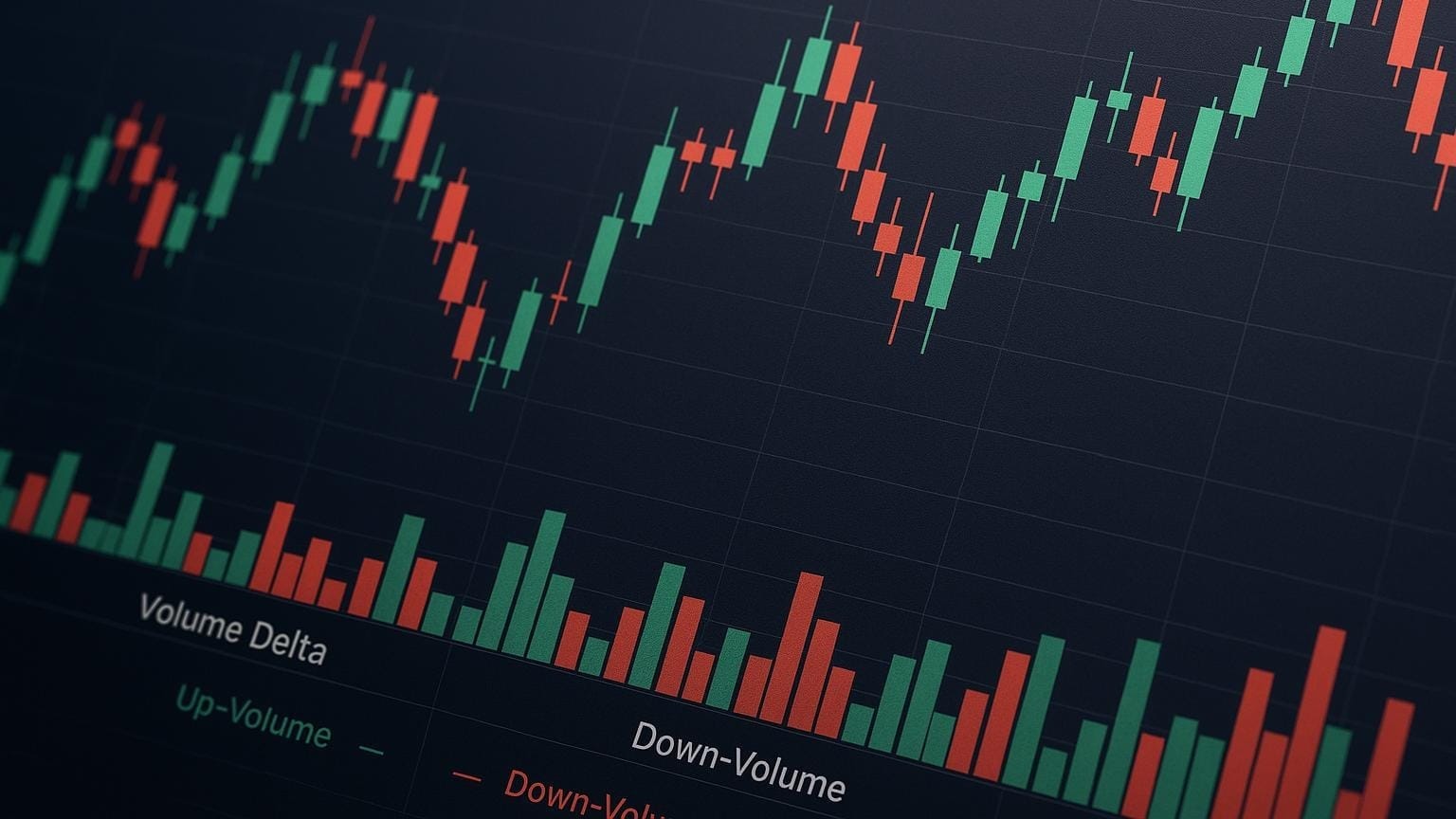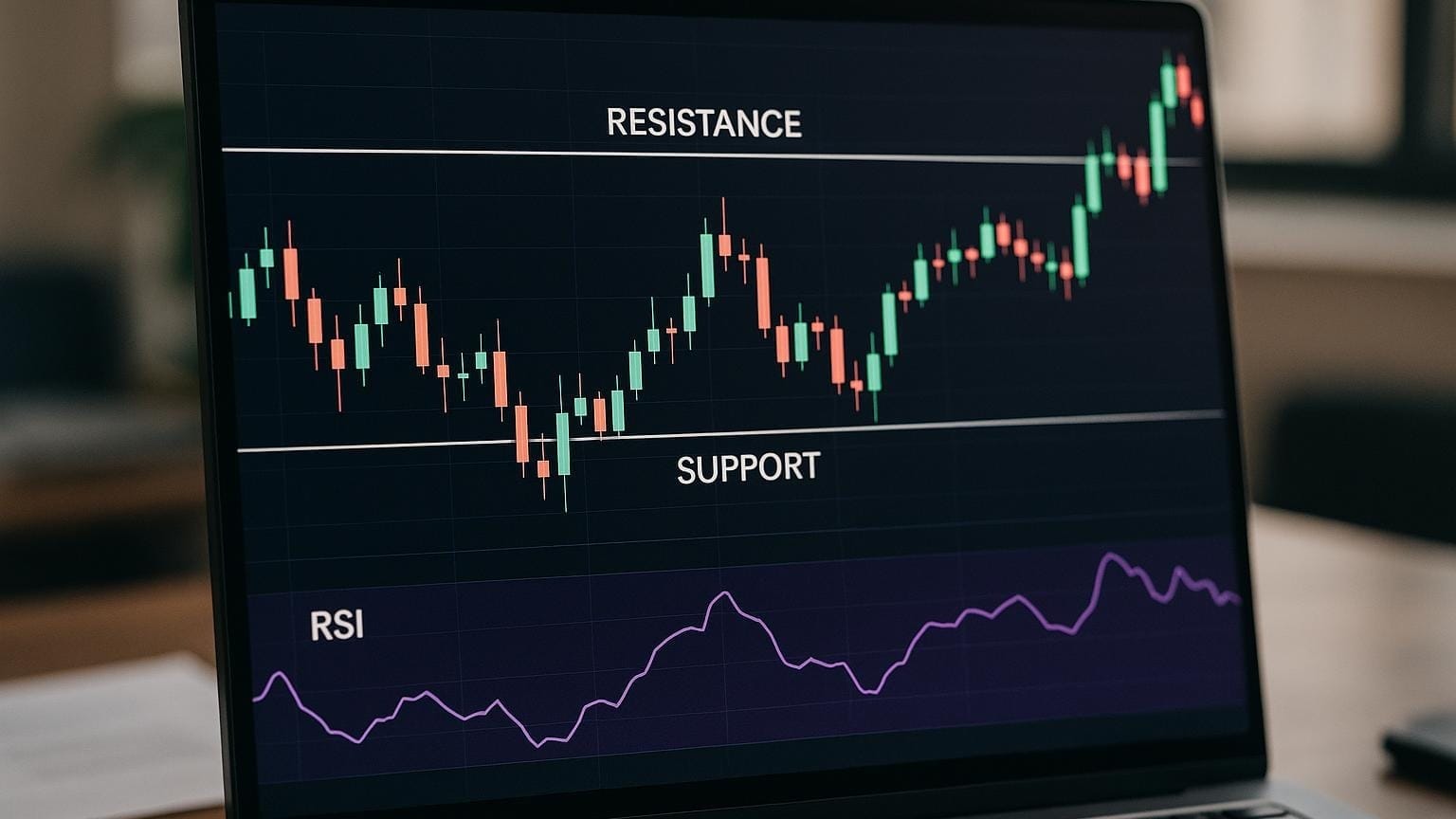Explore the Chande Momentum Oscillator, a unique tool for measuring market momentum that balances gains and losses to identify overbought and oversold conditions.
The Chande Momentum Oscillator (CMO) is a technical analysis measure created by Tushar Chande to gauge market momentum. Unlike many indicators, it factors in both price gains and losses, offering a balanced view of trend strength. The CMO ranges from +100 to -100, with practical thresholds at +50 (overbought) and -50 (oversold). These levels help traders identify potential trend reversals and momentum extremes.
Key Takeaways:
- Formula: CMO = 100 × (SU − SD) / (SU + SD), where SU = sum of gains, and SD = sum of losses.
- Interpretation:
- Above +50: Overbought.
- Below -50: Oversold.
- Near 0: Neutral momentum.
- Uses: Helpful for swing and trend trading, especially when combined with other indicators like moving averages or volume.
LuxAlgo provides CMO analysis on TradingView along with backtesting and visualizations that help refine trading strategies. The CMO is sensitive to settings like lookback periods and works best when paired with other analysis methods. You can also explore AI Backtesting to evaluate CMO-based ideas quickly.
How the Chande Momentum Oscillator Works
The CMO Formula
The Chande Momentum Oscillator (CMO) is calculated using the formula:
CMO = 100 × (SU − SD) / (SU + SD)
Here’s how it breaks down: SU represents the total gains from up days, while SD represents the total losses from down days over a chosen period. This formula balances gains and losses to create a percentage-based momentum reading. It’s designed to measure net momentum by comparing the strength of upward versus downward price movements. For background on momentum oscillators generally, see this overview of oscillator behavior and signals.
Let’s dive into how this calculation unfolds step by step.
Step-by-Step Calculation
The CMO calculation relies heavily on the lookback period, which determines how sensitive the oscillator is to price changes. Here's the process:
-
Step 1: Identify Up Days
Look at days where the current closing price is higher than the previous closing price. For these days, calculate the difference:
(Current Close − Previous Close)
Then, sum up all these positive differences to get SU. -
Step 2: Identify Down Days
For days where the current closing price is lower than the previous close, calculate the absolute difference:
(Previous Close − Current Close)
Add up all these values to get SD. -
Step 3: Exclude Neutral Days
If the current close equals the previous close, skip those days—they don’t contribute to the calculation.
Here’s a quick example to illustrate:
| Component | Calculation Process | Example |
|---|---|---|
| Up Days (SU) | Sum of (Current Close − Previous Close) for days when Current > Previous | Day 1: $102 − $100 = $2 Day 3: $105 − $103 = $2 SU = $4 |
| Down Days (SD) | Sum of (Previous Close − Current Close) for days when Current < Previous | Day 2: $100 − $98 = $2 Day 4: $103 − $101 = $2 SD = $4 |
| Final CMO | 100 × (SU − SD) / (SU + SD) | 100 × ($4 − $4) / ($4 + $4) = 0 |
Once you have SU and SD, plug them into the formula to calculate the CMO. A positive result means gains outweigh losses (upward momentum). A negative result indicates losses surpass gains (downward momentum). This calculation helps highlight momentum extremes in market trends.
Common Lookback Periods
The lookback period you choose plays a key role in how the CMO behaves. While there’s no universal "best" period, the length you select can significantly impact the oscillator’s sensitivity:
-
Shorter Lookback Periods
These make the CMO more responsive to quick momentum shifts, which can help spot rapid changes. However, shorter periods are also more prone to false signals caused by market noise. -
Longer Lookback Periods
A longer period smooths out the oscillator, reducing sensitivity to minor fluctuations. This can lead to fewer false signals but may delay the detection of real momentum shifts.
Your choice should align with your trading style and goals. For instance, swing trading often uses shorter periods to capture quick market movements, while longer periods help avoid reacting to short-term volatility. Testing different periods on historical data can help you find the right balance for your strategy.
Video: How the CMO Works
Reading Momentum Extremes
Once you've calculated the Chande Momentum Oscillator (CMO), the next step is interpreting its readings to make informed trading decisions. Understanding these values is crucial for identifying market extremes and recognizing when assets might be overbought or oversold.
Overbought and Oversold Levels
The CMO uses +50 and -50 as key thresholds to identify momentum extremes. When the CMO rises above +50, it can signal overbought conditions; a drop below -50 suggests oversold conditions and the potential for a rebound. Although the CMO ranges from -100 to +100, it rarely reaches those extremes in liquid markets, which is why +50 and -50 are more practical in day-to-day trading.
Traders can also fine-tune these thresholds based on an asset's historical volatility. For example, highly volatile stocks might require slightly wider thresholds, while more stable assets could benefit from narrower levels. Testing these adjustments with your specific trading instruments is essential to finding the right fit.
Neutral Momentum and Divergences
When the CMO hovers near zero, it suggests a balance between buyers and sellers—often consolidation—before a directional move.
Divergences between price action and the CMO can act as early indications of potential reversals. For example:
- A bullish divergence occurs when the price makes a lower low, but the CMO forms a higher low—hinting at an upward reversal.
- A bearish divergence happens when the price hits a higher high, but the CMO records a lower high—pointing to a possible downward reversal.
These divergences often align with chart patterns (double tops/bottoms, trendlines). For a primer on divergence mechanics, see this TradingView Learn guide on divergences.
CMO Trading Examples
The insights gained from CMO signals can directly guide trading strategies. For example:
- If a stock's CMO exceeds +50, traders might wait for confirmation—such as the oscillator rolling over—before considering exits or short setups.
- Conversely, if the CMO falls below -50, this oversold reading could present a buying opportunity after confirmation from structure or volume.
Here’s a quick reference table summarizing key CMO readings and their implications:
| CMO Reading | Market Condition | Trading Implication |
|---|---|---|
| Above +50 | Overbought | Consider exits or short setups with confirmation |
| Near 0 | Neutral | Likely consolidation; wait for clearer signals |
| Below -50 | Oversold | Consider initiating or adding to long positions with confirmation |
For instance, using a 14-period lookback, if the sum of gains is $120.00 and the sum of losses is $80.00, the CMO would be +20—indicating mild upward momentum. To enhance decision quality, combine CMO signals with broader context and other technical indicators.
Using the CMO in Trading Strategies
The Chande Momentum Oscillator (CMO) is particularly effective when paired with other tools. Instead of relying on CMO signals alone, seasoned traders integrate this momentum reading into systematic approaches to build more reliable trading systems. Let's explore how the CMO can enhance swing trading, trend trading, and optimization.
CMO for Swing and Trend Trading
The CMO is especially useful for identifying overbought and oversold zones, making it valuable for both swing and trend trading. Trend following benefits from using the CMO as a momentum filter: in strong uptrends, the CMO often stays elevated; in downtrends, it remains depressed. Swing traders often prefer shorter lookbacks (9–14) for responsiveness, while trend traders prefer longer (20–30) to filter noise.
Combining CMO with Other Indicators
To refine trading strategies, combine the CMO with complementary confirmations:
- Moving Averages: When price is above the 50-day average and CMO > +50, it strengthens bullish momentum. See our overview of moving averages.
- Volume Indicators: High volume alongside CMO extremes can signal stronger momentum shifts.
- Support and Resistance Levels: Oversold CMO near support can indicate potential entries; overbought near resistance can warn of reversals.
LuxAlgo’s Oscillator Matrix (OSC toolkit) can further enhance analysis by detecting real-time divergences across multiple momentum indicators for a more complete market view.
Backtesting and Optimization
Backtesting is essential for validating and fine-tuning CMO-based strategies. You can use AI Backtesting and the related guide to test CMO rules across timeframes and assets. For the concept of backtesting in general, see this overview of backtesting methodology.
This process helps identify the best CMO settings for different market regimes. Bull markets might require different thresholds than bear markets. Periodic reviews are equally important—conditions evolve, so re-test and adapt. Performance metrics from backtests can help set expectations, manage risk, and guide portfolio allocation.
Pros and Cons of the Chande Momentum Oscillator
When evaluating the CMO for your strategies, weigh its strengths and weaknesses. Like any indicator, understanding these trade-offs helps you decide how and when to use it.
Main Benefits
One standout feature is the dual focus on both price increases and decreases—unlike some oscillators that emphasize one side of price movement. By offering a balanced view, the CMO can be clearer during volatile periods when prices swing in both directions.
It also shows responsiveness to rapid changes in market sentiment. Normalizing within -100 to +100 makes it intuitive for spotting momentum extremes. Predefined thresholds (+50/-50) simplify decision-making.
Finally, the CMO is adaptable across styles—from short-term swing trading to longer-term trend following—helping with entries and exits in directional markets.
Known Limitations
The CMO rarely reaches its absolute extremes (+100/−100), so it may underemphasize the most dramatic conditions.
In low-volatility markets, it can hover near zero and cross that line frequently, producing whipsaws without additional confirmation.
Compared to classics like the Relative Strength Index (RSI), the CMO is less widely used, so there are fewer community resources. And because markets differ, fine-tuning by asset and timeframe is often necessary.
Comparison Table: Pros and Cons
| Advantages | Limitations |
|---|---|
| Dual focus accounts for both price increases and decreases | Rarely reaches extreme values (−100/+100) |
| Responsive to shifts in market sentiment | Whipsaws possible near the zero line in ranges |
| Predefined thresholds simplify decision-making | Less commonly used; fewer learning resources |
| Useful for swing trading and trend following | Requires optimization per asset/timeframe |
| Highlights momentum extremes & potential reversals | Performance influenced by market regime |
To use the CMO effectively, combine it with other confirmations rather than relying on it alone.
Conclusion: Using the CMO for Better Trading
The Chande Momentum Oscillator (CMO) is a practical way to spot momentum extremes. Its ability to measure both upward and downward movement offers a balanced view of market dynamics.
Key Points to Remember
The CMO’s calculation considers both gains and losses over a specified lookback (commonly 14 or 20). This dual-focus approach is especially useful in volatile conditions when prices swing in both directions.
The +50 and -50 levels are widely used thresholds. Readings above +50 suggest overbought conditions; readings below -50 suggest oversold conditions.
LuxAlgo enhances practicality with advanced visualization, customizable alerts, and backtesting features. These resources help interpret CMO signals objectively and reduce emotional bias.
For best results, combine the CMO with trend analysis, support/resistance, and volume indicators to validate signals and reduce false breakouts.
Next Steps for Traders
Here’s how to incorporate the CMO into your plan:
- Experiment with different settings using AI Backtesting. Start with 14, then test 10 and 20 to see what fits your assets and style.
- Set alerts for key CMO levels. Use LuxAlgo’s alert capabilities to track crossovers at +50/-50. You might also consider setting alerts around the zero line to catch early shifts.
- Practice on a demo account. Simulate entries such as waiting for a cross back above −50 before going long.
- Build a systematic approach. Document rules and review results regularly. LuxAlgo resources make it easy to iterate and measure performance.
FAQs
What makes the Chande Momentum Oscillator different from the RSI?
The Chande Momentum Oscillator (CMO) differs from the Relative Strength Index (RSI) in both its calculation and the insights it provides. While the RSI measures the speed and magnitude of price changes to identify overbought or oversold levels, the CMO focuses on the balance of recent gains versus losses over a specific period, which can be useful for spotting momentum extremes. Learn more about RSI here: Relative Strength Index explained.
How can I choose the best lookback period for the Chande Momentum Oscillator (CMO) based on market conditions?
The best lookback period varies with volatility. In volatile markets, shorter periods (9–10) increase responsiveness. In sideways markets, longer periods (20+) filter noise. An adaptive approach—adjusting the lookback based on volatility—can help. Validate choices through AI Backtesting.
How can traders use the Chande Momentum Oscillator (CMO) alongside other technical indicators to improve their trading strategies?
Combine the CMO with moving averages, volume, and market structure to confirm signals. For example, when the CMO is overbought, pairing it with a moving-average crossover or a MACD-based trend signal can add conviction for exits or hedges.
References
LuxAlgo Resources
- Reversal Signals (OSC Toolkit)
- HyperTrend (Trend Trading)
- Moving Averages: Uses & Tips
- Fetching Strategies (AI Backtesting)
- Price Action Concepts (PAC)
- Market Structure (Intrabar)
- Complex Adaptive Systems in Trading
- Volumetric Toolkit (Volume)
- Dynamic Support & Resistance
- Real-Time Divergences (TMO)
- AI Backtesting (Main Page)
- AI Backtesting: Complete Breakdown
- S&O Backtester (TradingView)
- Alert Scripting: Update & Actions
- MACD-Based Price Forecasting








